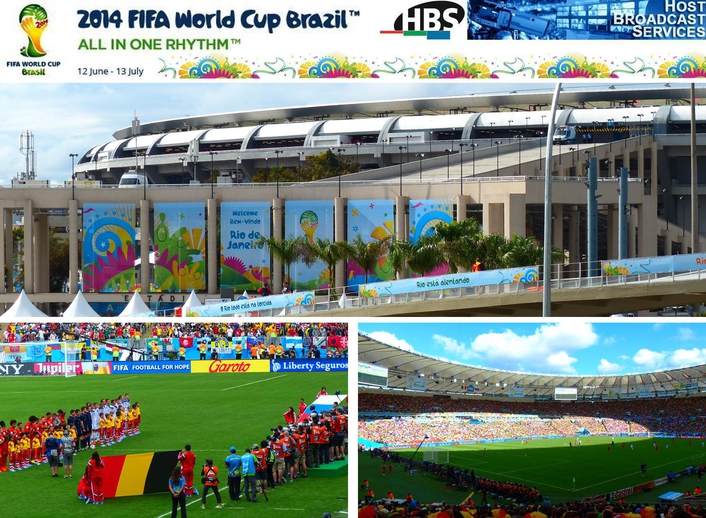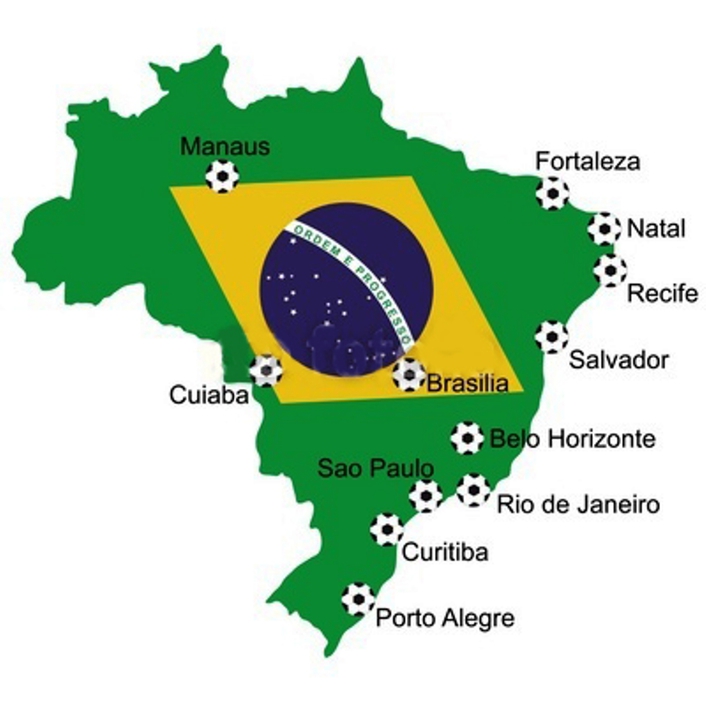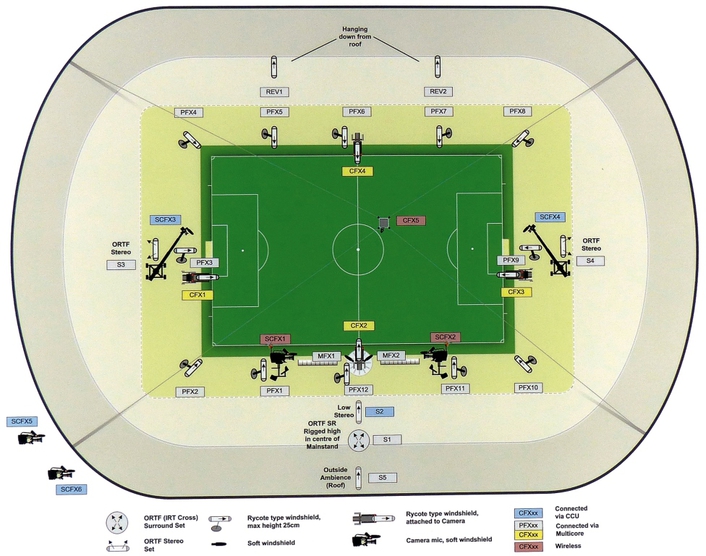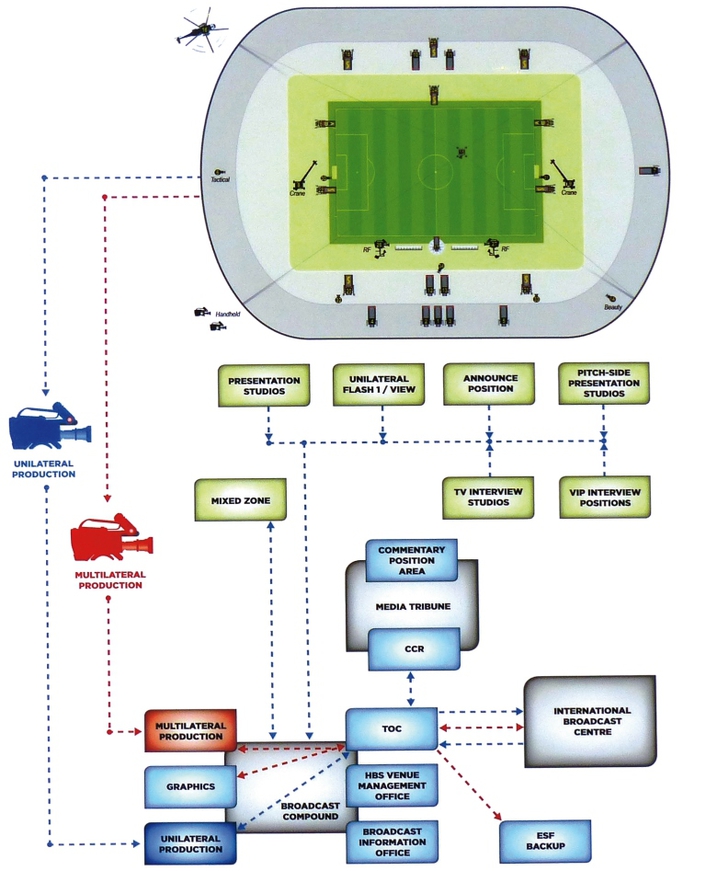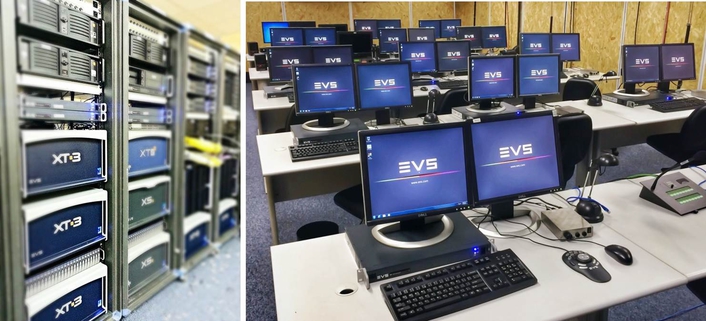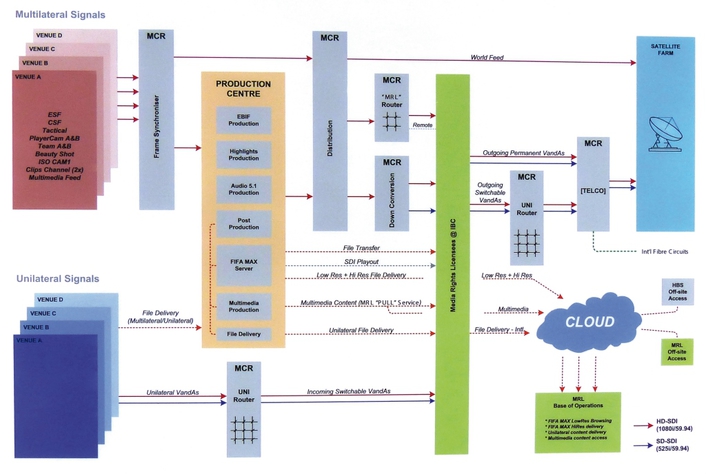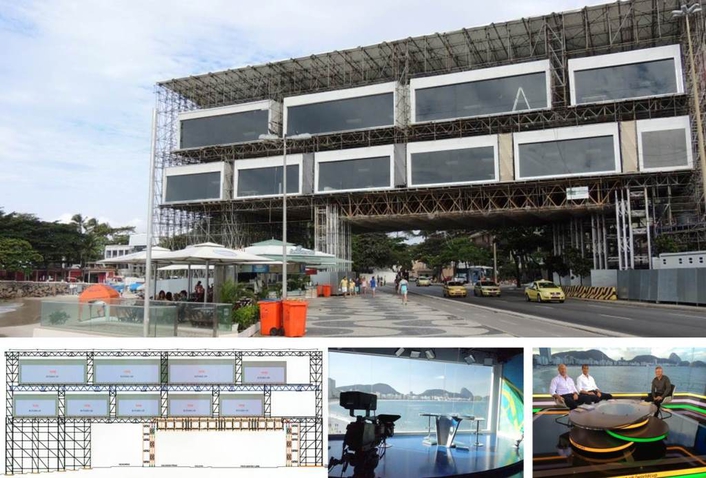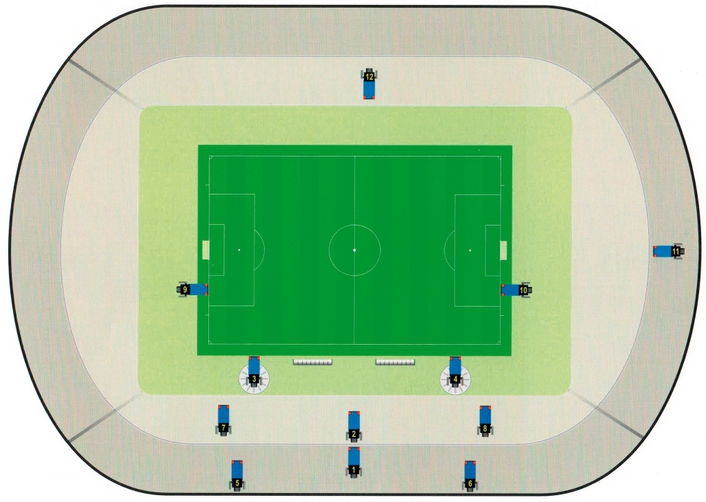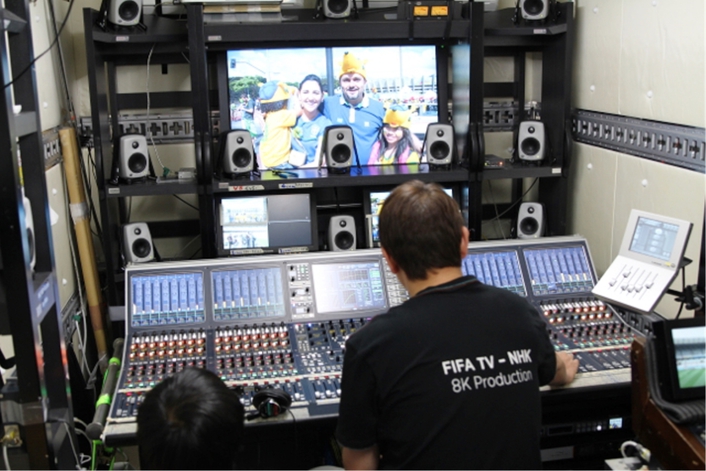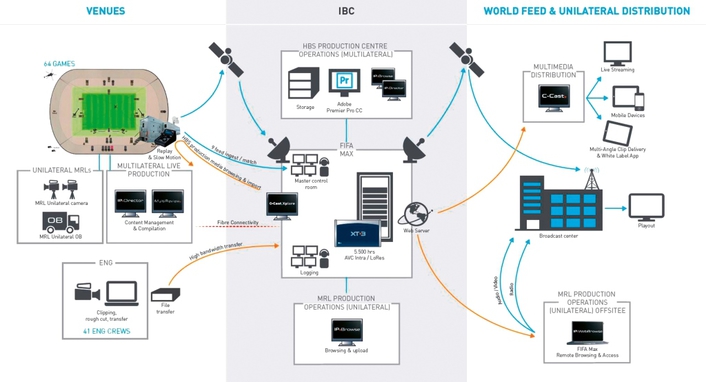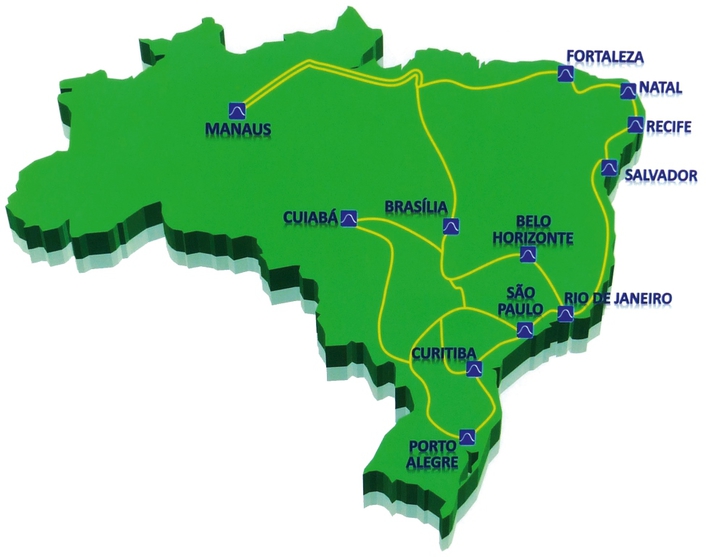HD and Multi-Media Production: FIFA World Cup™ 2014
posted:
It was with the help of a remarkable TV production team which consisted of over 2,000 professionals from FIFA TV, HBS, EVS, Sony, sonoVTS, Gearhouse Broadcast, deltatre and Eurovision. This team of highly skilled Live TV specialists delivered the world’s most watched football tournament to all territories on planet earth including the SpaceStation in orbit.
advertisment
New Developments
· The standard multilateral 29-camera plan (implemented at the 2010 FIFA World Cup in South Africa) was upgraded to a 34-camera plan to include the addition of two reverse corner cameras, one tunnel camera, an aerial/helicopter camera and a cable camera at every match.
· An additional clips compilation channel (the emotion/ultra-motion channel) was added to the multi-feeds.
· The content of the multimedia feed included half-time and full-time content, as well as the live match coverage.
· The start times of the extended stadium feed (ESF), clean stadium feed (CSF) and extended basic international feed show (EBIF) were reviewed and now provided the Media Rights Licensees (MLRs) with more content.
· Additional live Match Day-1 coverage was offered to MRLs.
· A new fully edited 26-minute programme, the FIFA TV preview show, was offered to MRLs
· A new section of the FIFA TV Extranet, the broadcast information platform (BIP) was developed to better meet MRLs’ need for broadcast related information during the event.
· A comprehensive multimedia content package was developed for the multimedia market around the world.
· The FIFA MAX server services were improved and extended.
· 43 ENG crews, one per participating team, nine across Brazil and two at the IBC. The 43 crews, operating Panasonic P2 HD camcorders, could plug in their laptops equipped with EVS Xedio Dispatcher to review shots instantly, manage rough-cut edits and log content before using one of the 38 Arkena (ex SmartJog) high-speed file injection points located across Brazil to transfer content to the International Broadcast Centre (IBC) in Rio de Janeiro.
· Goal-Line Technology (GLT) – Following the successful testing of GLT at the FIFA Confederations Cup 2013 GoalControl GmbH provided the solution also for the 2014 World Cup. The GoalControl-4D system used 14 high-speed cameras around the pitch. Wether a goal has been scored was confirmed automatically within one second by a vibration and visual signal on each match official’s watch. A resulting animation representing the ball’s crossing the line, or failing to do so, was made available to the FIFA Match Directors for relevant use.
advertisment
Production Standards
All 64 matches were covered in High Definition (HD) 16:9 format (4:3 safe). The technical standard was HD 1080/59.94i and all cameras including super slow motion (SSM) and ultra motion (UM) were HD. The audio production was in stereo and surround 5.1.The production plan took into account a number of parameters
· Recognizing that more and more MRLs are broadcasting in HD and Standard Definition (SD) widescreen while respecting that much of the global audience is still watching in analogue 4:3.
· The matches were increasingly seen by more than just the traditional TV audience, as multimedia outlets become more and more prevalent for highlights, goal alerts and even full match streaming.
· Production style and coverage remained uniform and impartial, with no destinction between better-known and lesser-known teams or players.
· The challenges the broadcast community was facing in their unilateral planning, both on site and at home, and a production plan that best supported them.
advertisment
Match Production Dream Team
The ”Match Production Dream Team” concept, established at the 2002 FIFA World Cup in Korea/Japan and adopted again with great success in 2006 and 2010, has been retained for the 2014 World Cup in Brazil. A match production dream team of eight match directors, selected from the top levels of the television industry, was assembled in order to bring the most talented football directors and their crews to Brazil. All eight FIFA match directors have extensive experience working for major TV channels, operating in the multi-camera HD environment.
The Technical Dream Teams
As HBS’ delivery partner for the 2014 FIFA World Cup tournament, Sony was responsible for the provision of all HD venue facilities in each of the 12 venues across Brazil, including systems integration, equipment and staff. This included managing the provision of 12 Equipment Room Containers (ERC) and 288 Sony full HD cameras, providing the production tools for HBS to deliver every minute of live match footage to broadcasters. Working with HBS, Sony has carefully selected its sub-contractors from a pool of leading facilities companies and equipment vendors that, when combined with HBS’ production crews, were second to none. The following companies were selected and collaborate with Sony to facilitate a full HD Live Production workflow for all 64 matches:
AMP VISUAL TV - RF Broadcast - CTV (Euro Media Group) - Outside Broadcast - Presteigne & Studio Berlin.
advertisment
AMP VISUAL TV: AMP VISUAL TV covered twenty matches (including a semi-final), played in the three host cities Sao Paulo, Porto Alegre and Fortaleza. AMP VISUAL TV was involved from the very first moment of the tournament, moving from the opening ceremony to the opening match in just a few seconds (with a complex equipment change). The three stadium cluster was managed by two French directors: Jean-Jacques Amselem and François Lanaud. The equipment used for each match - the same throughout the tournament - included 34 cameras and three mixers. Given the competition calendar, AMP VISUAL TV needed 50 cameras to cover its broadcasts.
Euro Media Group: During the tournament over 120 crew members from Euro Media Group companies have supplied the television coverage of matches from Natal, Recife and Rio de Janeiro as well as aerial coverage of all 12 host cities. In total, CTV, Euro Media France, United and Videohouse have deployed more than 60 Sony cameras for the production of the international signal for 16 matches, including a quarter-final and the final. The three stadium cluster was managed by two English directors: Jamie Oakford and John Watts. DVS (Digital Video Sud) delivered ultra motion shots from 36 matches with two Superloupe cameras at each match and ACS (Aerial Camera System) provided all aerial coverage of the tournament for HBS. The Aerial Unit’s team of 23 crew and 28 pilots completed over 500 flying hours throughout the World Cup.
advertisment
Venue Facilities
Three key technical facilities were established at each of the 12 venues – the Broadcast Compound, the Technical Operations Centre (TOC) and the Commentary Control Room (CCR).
Broadcast Compound: MRL technical facilities were located in the venue Broadcast Compound. It was reserved for OBVans, Fly-Away kits and other technical vehicles. The compounds were located as close as possible to the Field of Play access point, studios and media tribune to keep cable runs as simple as possible.
advertisment
Technical Operations Centre: The TOC, located in portable cabins in each venue’s broadcast compound, was the main distribution point and interface between production facilities, MRLs and the telecommunications provider. The TOC was the main operational area for signals. It accommodated all necessary equipment (routers, patch panels, audio and video monitoring and measuring equipment) and was connected to the Equipment Room Container (ECR). Multilateral feeds received from the HBS production facility were distributed to MRLs on site and were send to the Master Control Room (MCR) at the IBC. Unilateral VandAs to and from the IBC were also monitored and distributed from the TOC.
advertisment
Commentary Control Room: The CCR was the main operations centre at the venues for all commentary services and coordination circuits. The CCR was linked to its counterpart at the IBC, the Commentary Switching Centre (CSC), and the TOC at the venue. Interconnection between the venues and the IBC was established via a digital audio matrix with protected trunk lines. Commentary switching and distribution were entirely digital. However the circuits were delivered to MRLs as analogue audio signals.
advertisment
Multi-Feed Production
The multi-feed concept of combining different packages of feeds was retained for the 2014 FIFA World Cup, giving MRLs access to both the traditional match coverage and a full range of feeds including:
· Extended Stadium Feed (ESF)
· Clean Extended Stadium Feed (CSF)
· Extended Basic International Feed (EBIF) Show – a turnkey programme produced at the IBC
· A range of multi-feeds (Permanent Highlights Feed, Tactical Feed, PlayerCam A & B Feeds, Team A & B feeds)
· Clips Compilation Channel 1 – Action
· Clips Compilation Channel 2 – Emotion/Ultra Motion
· Isolated Camera Feeds
· Multimedia Feed
The multi-feed concept provided MRLs with extra flexibility:
· “Small” MRLs had access to coverage normally not available to them
· “Big” MRLs could focus their efforts and resources on producing additional features about the their respective national teams
· Pre-match: Much more material was available for use in the built-up to the match
· Live coverage: MRLs could enhance the ESF or tailor it to their specific audience by using supplemental feeds
· Post-match shows: MRLs could record the feeds, providing them with extensive extra coverage, including highlights, interviews, analysis and a “best of” selection of SSM and UM footage
Furthermore, content and services produced downstream, such as multimedia services, also benefited from this enhanced multi feed concept.
Audio Production Plan
The television international soundtrack (TVIS) was a broadcast quality stereo television sound mix produced to accompany each match. The TVIS was a mix of at least 12 pitch microphones (providing ball sounds) and atmosphere microphones. The TVIS sound mix provided exciting and immediate coverage of the match and crowd reactions closely reflecting the picture coverage. It was mono compatible. The TVIS mix combined the sound of the crowd, stadium, anthems and ball, with incidental camera coverage, including sound from Steadicams, pitch cameras, tunnel coverage and benches.
The mixed sound accurately reflected the on-screen picture content and provided viewers with the best in current television football stereo audio coverage. This mix was suitable for the majority of MRLs, who simply wanted to add their own commentary and presentation to each match.
The multi-channel international soundtrack (MCIS) was a broadcast quality 5.1 television sound mix produced to accompany the HD coverage of each match. The MCIS was a mix of at least 12 pitch microphones (providing ball sounds) and atmosphere microphones including specialist ORTF stereo and Surround arrays. The MCIS sound mix provided exciting and immediate coverage of the game and crowed reactions, closely reflecting the picture coverage, but with the added enhancement and involvement that multi-channel audio added to the coverage alongside HD pictures. The MCIS brought the viewer inside the stadium ambience. In order to provide MRLs with these specialized feeds, two controlled multi-channel mixing environments were created within the IBC, alongside the quality control room (QCR), which had multi-channel monitoring facilities.
The world feed distribution (EBIF Show) carried a Dolby E-encoded version of the MCIS. At the IBC, distribution of the EBIF Show and the MCIS was also available uncoded.
Multilateral Camera Coverage
The following cameras have been added to the multilateral camera plan since the world cup in South Africa:
· Reverse Corner Cameras (SSM) – Two reverse cameras were placed on the lower tier of the reverse side, approximately in line with the corner flags. These were super-slow motion cameras covering the blind side of the goal area.
· Tunnel Camera – The tunnel camera gave an additional view into the players’ tunnel while the teams were lining up before entering the pitch. It did not replace the existing cameras operating in that area; however it offered an additional point of view (POV). The camera was a remote pan/tilt head, attached discreetly to the roof of the tunnel. In each of the 12 stadiums the camera was installed, maintained and operated by TV Skyline.
· Ultra Motion (UM) Cameras – The UM cameras were positioned at the far side left and far side right on pitch level close to the 16m box mainly capturing close-up action of events taking place on the pitch. The direction of the cameras was different to the SSM cameras, as they did not necessarily follow the action where the ball was, focusing instead on player reactions, tackles and aesthetic images during play.
The UM cameras provided stunning images of action and emotion. A frame rate of 450-500 frames was used for match coverage. The UM cameras were fully integrated into the venue EVS infrastructure and dedicated operators were able to quickly provide replay clips to the match director.
Due to the length of UM replays, the use of these during match coverage was kept to a minimum. However, the new clips compilation channel “Emotion/UltraMotion” allowed for far greater use of these cameras’ output, thereby significantly boosting their value.
For half of the 12 stadiums the UM cameras were supplied by Fletcher (NAC/Ikegami HiMotion MKII) while for the other half Digital Video Sud, an Euro Media Group subsidiary, supplied the Phantom based “Superloupe” to HBS.
Following the approval and installation of a CableCam system (SpiderCam by PMT) at each stadium, aerial coverage with Helicopter for all 64 matches was introduced. The aerial footage was focused on team bus movements from their venue to the stadium, as well as producing stunning aerial views from the 12 host cities and surroundings during the pre-match coverage. Also the features production at the IBC benefited from these materials by adding aerial shots to selected stories when editorially relevant and increasing the value of these features.
Robotic Cameras at the FIFA World Cup Stadiums
A team of 32 technicians from TV Skyline were operating about 180 robotic cameras at the 12 FIFA World Cup stadiums in Brazil. Part of the 34-camera plan for each stadium was a tactical camera mounted on a GentleMote head very high behind the left goal, two BoxCams mounted in an elevated position in line with each goal, providing a clear view of the goal and its surroundings, two InGoal cameras positioned in the back top corner of the nets, providing a POV perspective inside of both goals, a BeautyCam providing a picturesque view from inside each stadium and finally the TunnelCam providing images of the gathering of the teams before they appear on the pitch.
In addition to these cameras TV Skyline operated between 8 and 20 ComCams for the commentary positions in each stadium. During the pre-round matches 80 ComCams were in operation and moved between the stadiums. Each MRL could book this service via HBS. The operation of the robotic cameras was quite efficient because TV Skyline was able to operate 10 or more of the commentary cameras with one person.
In Rio de Janeiro also two beauty shots of the city’s iconic landmarks were provided: The Sugarloaf from a robotic camera mounted on Rio’s Sul Tower and a shot along the Copacabana Beach with another robotic camera mounted on top of the nine TV Studios HBS had installed in front of the Sofitel at the Copacabana. The signals from Sul Tower were sent by RF (4km) to the TV Studios and then via fiber to the IBC at Riocentro. This enabled the control of pan, tilt, zoom and the remote control of a spinning glass that kept raindrops of the lens, from the IBC. Rounding up this impressive list of unmanned/remotely operated cameras were one which was mounted at the FIFA press conference room and another one mounted in the meeting room for the daily MRL briefings at the IBC.
The Equipment Room Containers (ECR)
In order to ensure the production of live replays, slow-motion action replays, highlights, and closers during any of the 64 matches, all 34 cameras were recorded on EVS XT3 production servers installed in the Equipment Room Container (ERC). One ERC was located for the duration of the competition in the TV compound at each of the 12 venues. The ERC was also home for the Sony camera control units, the Harris/Imagine routers, multi-viewers and digital glue products, the Sony vision mixer electronics, the Lawo audio mixer electronics, the Riedel Artist intercom matrix, and the Virtual Studio Manager (VSM) from L-S-B. The 12 ERCs were manufactured by HBS and the German system integrator sonoVTS in Munich. After testing they were shipped to Brazil. sonoVTS was also responsible for the delivery of the Cisco IT routers, the Guntermann + Drunck KVM switches, the Genelec audio monitors and the audio monitoring units from TSL and Sonifex.
Multi-Camera Recording
A total of 192 XT3 servers (16 in each of the 12 ERCs) have been deployed. These advanced digital video platforms managed the ingest of all cameras around the pitch. The systems were based on a loop recording process, so every single shot was captured. Their dedicated architecture (high redundancy and fault tolerance, insuring that nothing could interrupt the recording and live replay process) guaranteed a maximum level of control for instant replays, highlights editing, compilations and best moments, or graphic insertions managed by the production team during the matches to analyse critical actions and deliver the best of the live competition. Each server could simultaneously ingest and control up to eight feeds or cameras.
All the 16 XT3 servers in one ERC were on the same high-bandwidth media sharing network and optimized for live operations, allowing operators and production teams to share content and to control media recorded on any XT3 server: Any camera feed recorded on one server could be reviewed, clipped and played out from any other server on the network. All of the XT3s were also clustered on a standard Gb Ethernet network to facilitate media exchange with non-live activities, such as highlights editing and remote production tasks. The XT3 live servers were configured with the built-in proxy feature allowing live encoded content to be simultaneously available in proxy format to facilitate instant access, review, and content selection by MRLs and HBS teams located at the International Broadcast Centre (IBC) in Rio de Janeiro using the new remote access browsing interface C-Cast Xplore to import unseen sequences from the venues.
Multilateral On-Screen Graphics
The on-screen design of the multilateral graphics and animation packages was created by FIFA and HBS and all elements have been made available to MRLs ahead of the event. The multilateral graphics inserted during the match were integrated only onto the lower half of the frame to keep the upper half free for MRLs’ own graphic insertions. However, certain pre- and post-match graphics (e.g. starting line-ups) extended into the upper half. Accordingly, there was no permanent match score/running clock as part of the multilateral graphics. The running clock was inserted periodically into the score line graphics (with on-screen credits). Sony was appointed as FIFA’s official information technology partner and received the on-screen credits.
Match graphics were produced by HBS in cooperation with FIFA and deltatre, the on-screen graphics provider. The on-screen graphics were available in HD and SD and were designed in conjunction with the opening animation to provide a consistent on-screen design package. The design for the match graphics was kept simple so it did not distract from the on-pitch action.
In order for accurate and representative match data to be displayed with the graphics, experienced spotters gathered statistics during each match. The assembled inputs were made available in the online database within seconds after being entered. Once the data had been gathered and fed into the centralized database, it was available for use in different official applications such as TV match graphics and the commentary monitoring system (CMS).
The multilateral on-screen graphics presented relevant statistical information about the teams, match and players. This information included starting line-ups, the tactical positioning, group standings, match score, substitutions, individual and team statistics, team progression as well as weather conditions. All graphics presented on the ESF, Multimedia Feed and EBIF Show were in English only. They began with the pre-match programme and continued throughout the match and post-match programme. Other multilateral feeds did not contain permanent graphics during match coverage in order to make editing easier.
Player Tracking:
The 22 active players on the pitch and the ball were tracked in near real-time. This data was sent to the central results system (CRS), from where it was made available as a bookable service to multiple users. By analyzing the data, a selection of animated graphics displaying the most interesting and relevant facts about the player and team performances during the competition, were produced on each match day and used to enhance the EBIF Show and the multimedia content. Selected graphics were made available on the FIFA MAX server.
The chosen solution, provided by deltatre, acquired X,Y,Z coordinates in real time with the help of an optical tracking system. This system is based on sophisticated software algorithems to capture X and Y coordinates for every player on the field and X,Y,Z coordinates for the ball. Each “object” was covered multiple times (up to 15 times/sec), which allowed for virtual real-time tracking of player and ball movement.
Virtual Offside Line:
Following the successful use of virtual offside line graphics on ESF and CSF during the 2010 World Cup, these again were developed and produced for the Brazil tournament. The virtual offside line was added on site and was used sparingly and only when editorially relevant. No other virtual graphics were inserted on the main match feed (distance from wall, speed of kick, etc.). MRLs were not permitted to place their virtual systems alongside the 16m multilateral cameras, but were able to operate systems via picture recognition at the venue’s broadcast compound or at their premises at the IBC.
Match Analysis Tool:
The 3D sport analysis tool was provided by Viz Libero and was used for post-production purposes only. The system used the available TV camera images to generate virtual camera images, giving viewers the perfect perspective to analyze interesting or controversial scenes. The seamless combination of eye-catching 3D replays with powerful 3D effects, dynamic telestration and tied-to-field graphics created valuable analysis that was editorially supported by experienced football analysts. This was principally done for use in the EBIF Show, but these elements were also integrated into the multimedia content and were ingested in the FIFA MAX server.To describe the match stories HBS was using visual effects such as 3D camera-to-camera flight transitions, novel 3D perspectives and 3D flights, advanced tracking tools, virtual slow motion and player virtual runs. The Viz Libero analysis tools were directly connected to the deltatre central result system to access all player tracking statistics and data through the liaison offered by Magma Pro machines. This speeded up the analysis production process significantly, increased the accuracy of the match analysis features and gave the option to include real-time statistics during the analysis.
FIFA Media Asset Exchange (MAX) Server
The FIFA MAX server enabled MRLs to access footage from a dedicated library. This service was offered for the first time at the 2006 FIFA World Cup in Germany and was greatly extended in 2010, largely due to the additional content produced by the FIFA TV ENG crews. The FIFA MAX was once again a hub for production operations during the competition. As such, material generated by HBS was uploaded and logged onto the server and users connected to the system were able to search via dedicated browsing stations and transfer the material into their system for their unilateral programming requirements: The FIFA MAX server was the very heart of the broadcast and media infrastructure in the International Broadcast Centre (IBC) at the Riocentro Exhibition Centre in Rio de Janeiro.
The live ingest infrastructure was based on six EVS XT3 servers, providing ingest of a total of 28 simultaneous feeds, for a total capacity of 2,200 hours of HD. The recording operations were managed with the IPDirector ingest scheduler. For each match the ingest server recorded nine different feeds originated at the venue including
· Extended Stadium feed
· Clean Extended Stadium Feed
· Tactical/Interview
· Team A
· Team B
· Player A
· Player B
· Clips compilation 1 & 2
· ISO Feeds
The encoding format for ingested material was the Panasonic AVC-Intra. While recorded on the ingest infrastructure, the live feeds were automatically streamed into the central storage and exchange platform of the FIFA MAX server based on the EVS XStore SAN system. The nearline storage system offered a total capacity of 5,500 hours of HD and low res Proxy, with an internal bandwith of 50 Gbps and a storage size of 420Tb. Content ingested into the central storage was automatically generated in both hi- (AVC-Intra MXF OP1A) and low-resolution (H264).
From each match the following content was available for the MRLs and HBS: Match Feed - Clip Compilation - ENG - Features - FIFA Toolkit - City Profile - Analysis and Statistics - Match Highlights - World Cup Update Programme - Selected ISO Camera Records - Team Trainings and Press Conferences - Match Day -1 - Music Sequences - MRL Stock Exchange.
Fourteen IPDirector logging stations were operated by HBS to add keywords and descriptive metadata to the incoming feeds. This enabled quick and easy searches, downloads and transfers of any relevant media required by HBS or MRL production teams working on match highlights, special edits or archiving. The logging metadata was electronically associated with each file to identify its content.
The International Broadcast Center (IBC)
The IBC was located at Riocentro, an exhibition center about 30 km west from Rio de Janeiro. It was the central hub for all broadcast and multimedia production, exchange and distribution activities. HBS was responsible for the design, built and operation of the IBC and the full implementation of all unilateral services required by the MRLs located on site or in their home countries.
The IBC covered 55,000m² of raw interior space comprising of 17 TV studios, constructed spaces for multilateral and unilateral areas, a satellite farm of more than 6,000m², and a power farm with Aggreko generators of more than 2,000m². The 280 HBS team members based at the IBC managed the production, the quality check and the distribution of approximately 5,000 hours of coverage from the 12 venues and the 43 ENG teams to the international community.
Content Production at the IBC
Team Features – Approximately 125 features related to the 32 teams in the competition were produced. They were integrated into the EBIF Show programming and the multimedia production plan. They also were available to MRLs as stand-alone products. Two Team Features were produced per match with duration of approximately 2’30” including an English guide voice-over and were published on the FIFA MAX server, both with and without graphics.
Daily Team Updates – In addition to the two Team Features for each match, a short feature was produced daily for each of the 32 teams. The Daily Team Update was a simple “News Style” edit of 90 seconds duration, showing team activity (training, travelling, free time, etc.), including two or three sound bites selected from the daily interviews or press conferences.
Story Features – A number of Story Features were produced for use in the FIFA TV Preview Show and the multimedia production plan, and as stand-alone products. The Story Features were approximately 2’30” in duration. There was an average of three features per day throughout the tournament.
Promo Features – Promo Features production was hugely successful. A minimum of two per match and a number of additional tournament promos were produced for use in the EBIF Show, FIFA TV Preview Show and the Multimedia Production Plan, and as standalone products. The Promos were available to MLRs via the FIFA MAX server.
FIFA TV Preview Show – In order to deliver extra value to broadcasters, FIFA was offering MRLs an additional programme: the FIFA TV Preview show. Combined with the EBIF show, this programme completed the daily broadcast offering. It was aimed at the morning or “breakfast” market, previewing all the day’s matches, and was delivered as a two-part 26-minute commercial programme. It was produced at the end of each Match Day-1, focusing on activities at the training camps and the latest news related to each team before the match. It tapped into the massive amount of content gathered but rarely seen by smaller broadcasters.
FIFA TV Review Show – To celebrate the 2014 FIFA World Cup Brazil, a special FIFA TV Review Show of approximately 50 minutes in duration was produced. The FIFA TV Review show was a programme that looked back at the best moments, images and sounds of the tournament. It recapped the event in a highly stylized countdown approach. The use of high-end graphics, music and voice-over helped to provide a unique look of the World Cup in Brazil. This programme was first delivered on Friday 11 July, two days before the end of the tournament, giving MRLs the opportunity to play it out ahead of the Final. A second version of 52 minutes, including the trophy lift of the German team, was also produced and made available just after the Final.
Multimedia Content Production
The World Cup in Brazil was a global multimedia event and the second screen user was not bound by the constraints of a TV schedule or by the linear experience of a TV programme. Tablet devices and quasi-permanent connectivity (3G, 4G, LTE, Wi-Fi) have changed the way people consume an event. While watching the match live on TV remains the most popular way for people to follow the completion, a variety of other options were available.
In response to this new and rapidly developing sector FIFA has developed a wide range of multimedia services that complemented and enhanced MRLs’ multimedia coverage of the World Cup. More than 33 MRLs had booked these services. The services included white label apps, white label web players and component elements, fulfilling MRLs’ request for turnkey solutions as well as the need for elements to be integrated into existing solutions to adapt the look and feel of each individual MRL.
Licensed by FIFA, HBS selected EVS technologies for the distribution of live multimedia content to PCs, tablets, connected TVs and other smart devices. For the first time users were able to choose their own perspective of a FIFA world Cup. Using an interactive camera plan, fans were able to select and review multiple camera angles at any given moment – clicking on one of the icons on the plane changed the video instantly.
The production of component parts included the following services supported by EVS:
· Multimedia live matchcast
· Dedicated mobile/multimedia feed
· Additional Video-on-Demand (VoD) content
· Multi-angle content
· In-Match clip content,
· Multimedia and text messages (MMS and SMS)
· Interactive Data access
· Data visualization
The available user interfaces for MLRs included
· Apps for the major platforms (Android, iOS), mobile and tablet versions
· White label broadband services
Handling the technical orchestration of the content, the EVS C-Cast system provided an end-to-end second screen production solution for the delivery of multiple live steaming feeds (multimedia live matchcast), the multi-angle content and additional VoD distribution to sports fans on millions of devices worldwide.
The technical infrastructure of EVS integrated a multitude of leading technology solutions all working together offering the best interactive and multimedia consumption experience for viewers:
· Elemental Cloud for cloud processing of live feed streaming
· Aspera for the high-bandwidth file transfer from venue to the cloud based infrastructure
· Bright cove cloud based media transcoding operation
· Amazon S3 storage· Akamai content delivery network (CDN)
· NETCO Sports second-screen app designer
Multimedia Live Matchcast
The matchcast was a combination of the main match coverage with embedded data delivered via a live stream or file for a catch-up service. Viewers were able to choose from six camera angles during live streaming and as many as 24 for on-demand content. The six live feeds included the main match coverage, two player feeds (one per team), two team feeds (one per team) and the tactical feed.
During the design process of the C-Cast multimedia workflow it was obvious that video processing resources could become a bottleneck. During the 64-match World Cup schedule more than 3,900 hours of video processing (61.25 hours per game) were required to deliver premium live and catch-up coverage to viewers. Traditional hardware-based video processing solutions were not able to handle this massive spike in demand. EVS selected Elemental Cloud to address this issue to be able to deliver reliable high-quality, high resolution live content across multi streaming protocols.
During live matches six feeds (camera angles) recorded on EVS XT3 servers at the venue were automatically processed by EVS C-Cast Agent contribution encoders and were sent as 10Mbps streams to the IBC via a fibre network. At the IBC the incoming feeds were referenced by a C-Cast Central, while being delivered over fibre from the IBC to an Amazon S3 storage facility in Dublin where the EVS C-Cast production was deployed. Each incoming feed was fragmented in 2 seconds length packets for an efficient file delivery which were further re-consolidated in 6 seconds length packets by Elemental which then generated a bouquet of 10 different bitrates at 10 Mbps for delivery to MRLs globally via CDN. Some additional content could be imported by MRLs through Elemental and referenced with C-Cast Central to enrich the streams with dedicated content such as interviews, highlights and archive material.
Multi-Angle Content
For all major events of a match the best angles as well as sceens not seen in the matchcast were selected by four operators at the IBC. Approved clips were transferred as 10Mbps multi-angle clips to a dedicated storage area on the FIFA MAX server and transferred through Aspera over fibre from the IBC to the Amazon S3 storage facility in Dublin. Here the BrightCove Zencoder cloud-based transcoding system generated the appropriate formats (10 different bitrates) for the final delivery. The end-users saw these scenes appearing on the timeline of their devices together with a camera plan and were able to select the camera angle through which they would like to review the scene.
Multi-angle clips were made available in multiple resolutions and bandwidths. Access to multi-angle content was available through an API which enabled MRLs to directly implement the multi-angle experience into their existing multimedia environment. Delivery time for the first asset was approximately 3 minutes after the action was happening with at least three different angles.
IBC Technical Facilities
Master Control Room (MCR): The MCR was the central distribution point within the IBC for all incoming (venues and non-venue) and outgoing broadcast circuits (Telco and Satellite Farm). All incoming feeds through general telecom interfaces (fibre optic or satellite downlink) were monitored and distributed to MRLs as well as to the Production Centre within the IBC, regardless of the signal format (HD or SD). The correct distribution of incoming unilateral VandAs on bookable circuits/time slots to the respective MRL or directly to telecom interfaces was handled by the MCR. Outgoing unilateral feeds from MRLs and multilateral feeds from the Production Centre were monitored and distributed to the Telco Room and the Satellite Farm. The MCR control system for the central router system was renewed. Other than the MCR “Emergency” control panels, all router control panels were replaced by 24” and 10.2” touch screen displays offering more sophisticated features and control options to the HBS operational staff.
Commentary Switching Centre (CSC): Located adjacent to the MCR the CSC controlled and connected all national and international commentary and coordination audio circuits. After the successful implementation of computer-based audio circuit switching at the 2006 FIFA World Cup in Germany, the service provided to MRLs was further improved in 2010. The same audio matrix was implemented for this year’s World Cup, connecting all venues to the IBC with uncompressed high quality audio circuits, thereby shortening st-up times between matches. The entire signal path was redundant via protected WAN connections and was fully under control of HBS operational staff.
Production Control Room (PCR): The PCR was the central distribution point for incoming and outgoing feeds within the Production Centre. It also ensured that all individual exchanges of programme material proceeded smoothly inside the centre. The PCR deled with daily requests and technical requirements from the multilateral production facilities within the Production Centre. All feeds and multimedia content were switched through the PCR production router. The PCR controlled and monitored the ingest and outgest process of all multilateral feeds and other produced material to and from the FIFA MAX server, as well as the incoming file transfer, transcoding and ingestion of ENG materials.
Quality Control Room (QCR): The QCR served as the central point for HBS’ quality control and as the command centre of any audio and video content produced as part of the overall television production of the world cup. A separate QCR for the multimedia production was located in in the multimedia area of the Production Centre. A large monitoring gallery allowed simultaneous monitoring of all feeds produced by the Match Production Teams at the venues as well as by the various production personnel at the Production Centre, showing all multilateral feeds produced at the venues and the IBC – including all feeds ingested/outgested onto/from the FIFA MAX server.
EBIF Show Live Production Rooms: The EBIF Show feed was produced live at the IBC. There were two dedicated live EBIF Show Production Rooms where all the various elements of the pre-match, half-time and full-time programmes (titles, features, live match coverage, match highlights, analysis, voice-over guide, graphics, etc.) were mixed to produce the programme for the 64 matches of the event – working in parallel during the simultaneous matches. There were also two multilateral Permanent Highlights live production rooms scheduled to cover all matches and to work in parallel during the simultaneous matches. A 5.1 Surround Sound mix was produced to accompany all the matches. This mix complemented the HD streams and was also available to SD MRLs. There were two 5.1 Surround Sound production rooms at the IBC – both were equipped with Lawo m²56 consoles.
Outside Presentation Studios (OPS)
Nine OPS were located on Avenida Atlantica in front of the Sofitel hotel, offering an iconic view of Copacabana Beach and Sugarloaf Mountain. When broadcasters with space at the Outside Presentation Studios welcomed their audience for the Opening Match of the 2014 FIFA World Cup Brazil™ there was no mistaking their presence in the host country - the view of Sugarloaf Mountain had never looked as good as it did from the OPS. The problem was that the best view identified was from the end of Copacabana Beach on Avenida Atlantica, a main traffic artery in Rio's Zona Sul. HBS' solution was to construct the studios on top of a nine-metre high platform that would straddle the road and pavement, without affecting pedestrians and vehicles.
Standing 22 metres tall in total, 57 metres in length and 50 metres in width the giant structure offered studio sizes of 56m² and 108m² and was connected to 37 porta cabins and generators on-site. Each studio offered 1 GbE connectivity to the IBC, sound isolation and wireless connectivity to enable camera crews to shoot from the famous beach. Eleven broadcasters from eight countries, including beIN Sports, BBC, KBS, ITV, SKY Italia and SBS Australia chose to broadcast from the OPS.
Pushing New Boundaries with 4K
This year saw the next evolution in sports broadcasting with the first ever 4K World Cup coverage. A game-changer for live sports production, three matches - including one of the round of 16, one Quarter Final and the Final (all staged at the Estadio Maracanã in Rio de Janeiro) - were captured in live 4K, creating the most immersive, visually spectacular viewing experience sports fans have experienced yet.
Working together, Sony and HBS were responsible for the 4K project in Brazil. Sony had selected Brazilian outside broadcast and programming company Globosat (part of TV Globo Group) and UK-based outside broadcast company Telegenic to provide the production platform. Globosat was responsible for the provision of its 4K OB truck with a Lawo mc²56 audio mixer and a Clear-Com Eclipse intercom matrix, whilst Telegenic brought their technical expertise and experience, gained at the Confederations Cup 4K trial last year, to the project. Both companies have been chosen because of their reputation as innovators in their fields, bringing a wealth of expertise in live sports production and reputations for broadcast excellence. Fujinon was providing lenses for the 4K production.
The three 4K productions were carried out with 12 Sony PMW-F55 cameras and a Sony F65 (recording at 120 frames per second for slow-motion replays was the only “prototype” in the production), 7 EVS replay servers as well as a Sony PWS-4400 4K replay server for the slow-motion replays, PVM-X300 4K LCD monitors and a MVS-7000X 4K multi-format switcher. There were also eight HD sources from the HD production that were up-converted and made available for the 4K productions.
The EVS XT3 4K servers were capable of recording two inputs and playing out one versus last year at the Confederations Cup when they were one input and one output. That means that all cameras now were available for replay.
But the biggest advance was actually within the Sony production switcher as it was much easier to set it up and operate during the match.
The use of the eight HD sources gave the production team the flexibility to work around issues like 4K RF, which is an area that needs a lot of work and is currently not feasible. However up-converted aerial cameras and Steadicams made the production more complete.
For the advanced 4K production facility at the IBC, Quantel’s high quality color and finishing systems were chosen by Sony. The Quantel GE2 system, which includes two Pablo Rio 4K color correction and finishing systems sharing storage and workflow via a GenePool, were used for the production of fast-turnaround 4K highlights packages. These were distributed to broadcasters and Sony Stores worldwide as well as being displayed on 4K screens in fan parks around Brazil. The Quantel system will also be used for the post production of the Official FIFA World Cup™ film in 4K Ultra HD.
The Quantel system worked with 4K 60p XAVC media recorded on either the Sony PMW-F55 cameras which were used by FIFA Film crews throughout the competition or the Sony Servers used for the 4K Live Production of three matches played at the Maracanã Stadium. All XAVC media was instantly available for viewing and editing on the Pablo Rio colour and finishing systems thanks to their ability to begin work immediately with soft-mounted media without transcoding or importing. The Quantel system recorded live 4K 60p via Quad 3G SDI, which was edited even while recording.
8K Match Production
FIFA TV has a proud legacy of pioneering new television technology at FIFA tournaments to ensure that football fans around the world can enjoy the best quality sports coverage on offer.
The 2014 FIFA World Cup Brazil was no different with the very latest in visual technology either being used in the broadcast production of key matches and events or being tested for use in future competitions.
While many of the world’s broadcasters are still looking to the next stage of TV standard, NHK was making a huge show in Brazil of its ultimate plan, which is to see 8K Super Hi-Vision start broadcasting in 2020.
As a collaborative project NHK (Japan Broadcasting Corporation) and FIFA co-hosted a series of live and recorded public viewings of nine matches in 8K Super Hi-Vision at the Sofitel in Rio de Janeiro at the Copacabana (FIFA Official Hotel), CBPF (Centro Brasileiro de Pesquisas Fiscas) and the IBC SHV screen.
In addition to the presentation at the three viewing sites in Brazil NHK was beaming the nine FIFA World Cup matches in 8K back to Japan. NHK was travelling with its SHC-01 8K OBVan from Receife (Cost of Ivory – Japan), to Natal (Ghana – USA and Japan - Greece), to Brasilia (Cameron – Brazil) to Belo Horizonte (Chile – Brazil) back to Brasilia (France – Nigeria and one Quarter Final) further on again to Belo Horizonte for one Half Final and finally to Rio de Janeiro for the 2014 FIFA World Cup Final. These nine matches were shown in Japan in Tokyo, Yokohama, Osaka and Tokushima on giant screens.
The signal of the nine matches was generated by three Ikegami SHV-8000 8K cameras, two FOR.A FT-ONE high speed cameras (up converted from 4K to 8K) and one Sony F-65 camera for location shooting.
The 8K OBVan was travelling together with an audio truck for the recording of 22.2 surround sound on a Lawo mc²66 MKII console, a transmission truck and an equipment truck. The Brazilian tour of the four trucks was more than 4,200km long.
The signals from the nine matches were transmitted to Tokyo via CBPF for Public Viewing. They were also down-converted to 4K at the IBC in order for the integration into the FIFA TV- Sony 4K production to make up the Official FIFA World Cup™ film.
Director of FIFA TV Niclas Ericson said: “With Ultra HD technology, such as 4K and 8K, we are exploring imagery that is truly at the cutting edge of TV production. We are proud to be able to innovate in this way to improve the viewing experience for football fans around the world. The new technologies also include ground breaking standards in sound quality, bringing the viewer almost ‘into the stadium’.”
Facts & Figures
General Information
· Edition of the FIFA World Cup 20th
· Opening Match 12 June 2014
· Final 13 July 2014
· Number of participating Teams 32
· Number of Matches 64
· Number of Territories reached 220
· Main TV Licensees 161
· Sub-Licensees 305
· Radio 150
· All territories of the world were covered with contracts
Production
· Number of Cameras in Standard Camera Plan 34
· FIFA World Cup “Dream Team” Match Directors 8
· Number of different feeds 20
· Unilateral camera positions per match up to 70
· Total hours of coverage (including ENG teams) 5,000 approx.
· Total number of cameras 300+
· Crane cameras 24
· Cable-Cam systems 12
· Aerial camera flying hours 500+
· Number of ENG Crews (Team/Story/IBC) 43 (32/9/2)
· IBC production staff 280
· Field production staff 150+
· Number of beauty shot locations in Rio de Janeiro 2
· Edit suites (regular production/multimedia) 36 (18/16)
· 4K FIFA-Sony production 3 matches in Rio de Janeiro 12 cameras Live
· 8K FIFA-NHK production 9 matches 5 cameras
Telco
· Number of venues permanently connect to the IBC 12
· File transfere services across all venues 12
· Additional file transfere injection points across Brazil 26
Multimedia
· Number of MRL agencies taking multimedia content 33+
· Number of countries reached with multimedia content 80+
· Number of multimedia service orders 100+
International Broadcast Centre (IBC)
· Raw indoor space 55,000m²
· Constructed space for multilateral areas 8,305m²
· Constructed space for unilateral areas 13,225m²
· Production Centre 2,620m²
· ENG Centre 352m²
· TV Studios 17
· Largest TV Studio 400m²
· Largest unilateral area 2,250m²
· Smallest unilateral area 22m²
· Satellite Farm 6,000m²
· Technical compound (power generator) 2,000m²
· Installed capacity of air conditioning system 1,311TR
· Air conditioning units 570
· Electrical boards 145
· Lighting Fixtures 3,372
· Double sockets – domestic power 3,425
· Primary electrical cable 67,542m
· Secondary electrical cable 49,749m
· Fire detection cable 9,278m
· Smoke detectors 1,121
· Video circuits 300
· HD CATV 40” screens 350
· Elevated Outside Presentation Studios at Copacabana 9
· Start of Construction 2 Dec 2013
· Total construction time 5 months
· First MRL arrival 12 May 2014
· IBC fully operational 3 June 2014
· Total dismantling time 7 weeks
Logistics
· Accredited event time staff 2,900+
· MRL accreditations 15,000
· Supplementary Access Devices (SADs) 52,000
· Crew uniform items 50,000
· Hotel room nights 80,000
· International flights 3,000
· Domestic flights 1,400
· Car rental days 11,500
· Bus rental days 1,000
· Charter flights 46
· People/tons of equipment per charter flight 110/5 tons
· Air freight 150 tons
· Sea containers 100
· Pallets with cameras, tripods and lenses 200
· Meal vouchers distributed 43,000
Venues
· Number of Venues 12
· Staff at Venues 1,875
· Total number of commentary positions 1,210
· Commentary positions with ComCam 6-20 per venue
· Total number of commentary units 840
· Total number of TV Studios 34
· Total number of Presentation Studios 56
· Video Switching Systems 40
· Cabling across all venues 1,167km
· Total compound space at venues 54,000m²
Human Resources
· Total number of staff during event time 3,018
· Number of Nationalities of staff 48
Booking
· Services in the Catalogue of Services (COS) 436
· MRLs (41 nationalities) with unilateral space 86


